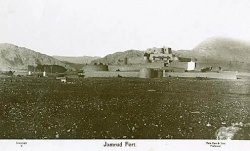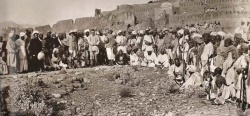The Nalwa Wall: Difference between revisions
Allenwalla (talk | contribs) |
Allenwalla (talk | contribs) |
||
| Line 24: | Line 24: | ||
*Shankargarh | *Shankargarh | ||
On the Swat river there was a strategic place where three routes met. These three routes were one from Kabul, another from Hashatnagar which was an Afghan settlement on the extreme north, and the third was Gandhav Pass a minor opening. Hari Singh constructed a fort here. It was names as Shankargarh. There were stationed 500 infantry, 300 cavalry, 35 artillery men, two big and 10 small cannons. It was placed under lehna Singh Sandhanwalia, a well-known warrior. (35) | On the Swat river there was a strategic place where three routes met. These three routes were one from Kabul, another from Hashatnagar which was an Afghan settlement on the extreme north, and the third was Gandhav Pass a minor opening. Hari Singh constructed a fort here. It was names as Shankargarh. There were stationed 500 infantry, 300 cavalry, 35 artillery men, two big and 10 small cannons. It was placed under lehna Singh Sandhanwalia, a well-known warrior. (35) | ||
[[Image:Jamraudfort.JPG|right|250px |Fatehgarh Sahib]] | |||
[[Image:Jamrudfort1870.jpg|right| 250px |thumb|Jamraud Fort in 1870]] | |||
*Fatehgarh Sahib or [[Jamrud]] Fort | *Fatehgarh Sahib or [[Jamrud]] Fort | ||
Revision as of 15:59, 10 January 2008
This article is currently under developement
The Nalwa Wall a ring of forts developed by Hari Sing Nalwa. For hundreds of years westerners had thundered through the passes of the Hindu Kush. Long befor Babar the Afganis, Persians and then the Afganis again had come to India to rob it of its riches.
Under Maharaja Ranjit Singh who appointed Hari Singh Nalwa to take over the defence of the passes through these invaders , murderers, scavengers and even conquerors came a system of forts were established to once and for all but an end to these foriegn invasions.
General Nalwa the greatest general of the Khalsa studied the situation and the terrain and established a ring of fort to preclude any futher invasions.
The Nortwestern defenses
Hari Singh Nalwa knew how to match the Sikh hatred by Afghans. He set up a very strong administration in the Peshawar valley. He levied a cess of rupees four per house on the Yusafzais. This cess was to be collected in cash or in kind. For its realization personal household property could be appropriated. There was scarcely a village which was not burnt. In such awe were his visitations held that his name was used by mothers as a term of fright to hush their unruly children. (30) It was prudently realized that although the spell of Afghan supremacy was broken the region predominantly populated by turbulent and warlike Muhammadan tribes could not be securely held unless a large army was permanently stationed there. A force of twelve thousand was with Hari Singh Nalwa to quell any sign of turbulence and to realize the revenue. The terror of the name of the Khalsa resounded in the valley. Part of the city of Peshawar was burnt and the residence of the Barkzai governors at Bala Hissar was razed to the ground. Hari Singh Nalwa strengthened the Sikh position by garrisoning the frontier forts. (31)
The Ring of Frontier Forts
In order to consolidate the defence of the north-western frontier, Hari Singh Nalwa examined the topography of the Peshawar region. There were three rivers following from Afghanistan to Peshawar forming three water routes as well as land routes. The highest tributary of the river Indus on the western side is the River Kabul. Kabul the capital of Afghanistan and Jallalabad are situated on the banks of this river. Nawshehra where a decisive battle had been fought in 1823 A.D. between the Afghans and Sikhs is also situated on the bank of this river.
The second important river is Barba River. It is a tributary of River Kabul and joins it from the southern side. Peshawar which the capital of the region is situated on its banks. The Swat River which is also a tributary of River Kabul joins it from the north. Hari Singh Nalwa decided to build forts in this terrain in order to check infiltration of, and the invasion of the Afghans on all these routes. The nearest mountainous pass to Peshawar is the Khaibar which is only nine miles from Peshawar.
- Michni fort.
On the previous occasions all important invaders had invaded India through it. Hari Singh Nalwa decided to construct forts on all these strategic points. On the bank of the River Kabul, Michni, a fort, was constructed and it was put under the command of Nichhatar Singh, (32) son of a well-known general Dhanna Singh malwai. In this fort were stationed 300 infantry men, 100 horsemen, 10 artillery men, two big and two small cannon. (33)
- Barha fort.
On the bank of the River Barha also a strong fort was built.Three hundred infantry, 100 cavalry, three cannon pieces were placed there and the required provisions were supplied. It was placed under Jhanda Singh Butalia. (34)
- Shankargarh
On the Swat river there was a strategic place where three routes met. These three routes were one from Kabul, another from Hashatnagar which was an Afghan settlement on the extreme north, and the third was Gandhav Pass a minor opening. Hari Singh constructed a fort here. It was names as Shankargarh. There were stationed 500 infantry, 300 cavalry, 35 artillery men, two big and 10 small cannons. It was placed under lehna Singh Sandhanwalia, a well-known warrior. (35)
- Fatehgarh Sahib or Jamrud Fort
But the most important route was through the Khaibar Pass which had been the traditional route for the invaders since the times immemorial. After surveying the entire area Hari Singh spotted a small mound on the eastern end of Khaibar Pass which was a part of the nearby village of Jamrud. It had the remains of a small mud fort. Hari Singh decided to build a fort there. Necessary material was collected and a foundation of a very strong fort was laid there on October 17, 1836.
Hari Singh Nalwa himself laid the foundation of the fort after offering prayers. The masons and the labourers were working there continuously and they were able to finish this historic fort after a month and twenty-five days. Its walls were four yards wide, 12 yards high. It was named as Fatehgarh Sahib. (36) Inside this fort were stationed 800 infantry, 200 cavalry, 80 artillery men, 10 big cannons and 12 small cannons.
Maha Singh, a seasoned general, was appointed the commander of the fort. The fort faced scarcity of water which was overcome by harnessing a nearby stream that was under the control of the Afridis. The Afridis were offered a jagir worth Rs. 122/ - in return for control over the stream. An alternate arrangement of water was also made within the fort to face any eventuality by digging a big well. (37)
- Burj Hari Singh
Another important fort was built on the road leading to this fort linking Peshawar. It was just in the middle of the way between Jamrud and Peshawar. (38) It was named Burj Hari Singh and 100 men were stationed there.
- Old forts like Attock, Khairabad, Shubkadar and Jehangir repaired and Garrisoned with Sikhs. (39)
Interlocking System
This line of forts on the north-western side were linked by roads so that reinforcements could reach each fort in the time of crisis. Peshawar was strongly fortified and was linked with Attock by a line of towers erected at a distance of every two Kos. (40)
Alarmed Afgans attack
All these defence measures of Hari Singh Nalwa alarmed the Afghans Dost Mohammad and Burkzai Chief of Kabul. The Afghans apprehended that their dangerous neighbours would make an inroad beyond the formidable defence. Therefore, they resolved to put a stop to any further advance of the Sikhs into the tribal area. A force of 8,000 strong with 50 cannons under Akbar Khan and Abdul Samad Khan proceeded towards the Khaibar to dislodge the Sikhs from Janrud. The cry of jehad swelled their ranks to 20,000 horse and foot. Hari Singh Nalwa was killed in the battle of Jamrud most valiantly in 1837 A.D. (41) Thus ended the life of a great general who had become a terror to Afghans. According to Griffin, Hari Singh Nalwa was the “bravest of the Sikhs Generals - the most dashing general - fertile in recourse and prompt in action”.
‘Ney of Punjab’
Edward Lincoln writes, “Hari Singh Nalwa carried the title of ‘Ney of Punjab’ and whose exploits in extending the Sikh dominion were hardly eclipsed by those of Maharaja Ranjit Singh himself”. (42)
References
1. Aveen Akbary, Francis Gladwin (tr.) Vol. II, Calcutta 0 1784, pages 191-204 2. Attock area was east of the River Indus but was adjoining the Hazara District which was north of District Attock. 3. Attock District Gazette, Lahore, 1932, page 47. 4. For the effects of Nadir invasions see Sarkar, J.N.; Fall of Mughal Empire, Vol. I, Calcutta - 1971, p. 2-3 3. Sinha, N.K., Rise of the Sikh Power, Calcutta - 1973, p. 8. 4. Qazi Nur Mohammad, Jang Namah, ed. Ganda Singh, Amritsar, 1939, p. 60. 5. Gupta, Hari Ram History of Sikhs, Vol. II, Delhi, 1978, pg. 239-45. 6. Hoshiarpur, The Life and Times of Ranjit Singh, 1977, p. 60. 7. Griffin Lapel H. The Chiefs and Families of Note in the Punjab, Vol. I, Lahore, 1940, p. 415. 8. cit.op, Vol. II, p. 87. 9. Sinha N.K. Ranjit Singh, Calcutta, 1968, p. 60. 10. Chiefs and Families of Note, cit. op., Vol II, page 87. 11. Hoti Prem Singh hari Singh Nalwa, (Punjabi) Ludhiana, 8th edition, p. 164-65. 12. Ibid, Surinder Singh Johar, Hari Singh Nalwa, New Delhi, 1982. 13. Ain-i-Akbari, cit, op., page 14. The Ibbetson, Punjab Castes, Lahore, 1916, p. 63. 15. Ibid, p. 64 16. Prem Singh, Hari Singh Nalwa (Punjabi) cit. op. p. 165. 17. Baron Von Hugel, Travels in Punjab & Kashmir cit. op. p. 207. 18. Surinder Singh Johar, Hari Singh Nalwa, cit. op., p. 93. 19. Baron Von Hugel, Travels in Punjab & Kashmir cit.op. p. 207. 20. Ibbetson, Punjab Castes, Lahore, 1916, p. 63. 21. Prem Singh, Hari Singh Nalwa (Punjabi) cit. op p. 267. Shinkiari is in modern tehsil of Manera (dist. Hazara) and is at eleven miles from Mansera. 22. Cunningham, A History of the Sikhs, (Oxford University Press, 1918, p. 199). 23. N.K. Sinha Ranjit Singh, Calcutta, 1968, p. 62. 24. Ibid page 80, Oalif Carv, The Pathans, London, 1962, p. 150. 25. Sham Singh Attariwala was one of them. For details see Kirpal Singh Sham Singh Attariwala, (Punjabi) Patiala, 1978, p. 204. 26. Sita Ram Kohli, Maharaja Ranjit Singh (Punjabi) Delhi, 1951, p. 153. 27. Sinha N.K. Ranjit Singh cit. op. p. 110, Griffin Chiefs & Families of Note in Punjab, vol. II cit.op. page 88. 28. Hasrat B.T. Life & Times of Ranjit Singh, Hosiarpur, 1977, p. 134-35. 29. Idea. 30. Peshawar District, page 70, Quoted in Life and Times of Ranjit Singh. cit. op., p. 137. 31. Life and Times of Maharaja Ranjit Singh, cit.op., p. 136. 32. Ibid, page 245. 33. Surinder Singh Johar, Hari Singh Nalwa, New Delhi, 1984, p. 148. 34. Ibid, p. 148. 35. Ibid, p. 242. 36. Ibid, p. 243. 37. Ibid, p. 243-44. 38. Sinha N.K. Ranjit, cit.op., p. 111. 39. Ibid, p. 111. 40. Chiefs and Families of Note in Punjab, Vol. II, Lahore, 1944, pages 87,89,90. 41. Gujranwala District Gazetter part A, Lahore, 1935, p. 29.
Source
The Source Book On Sikhism
- Edited by Dr. S.S. Sodhi, Halifax, Canada
- Dr. J. S. Mann, Fullerton, California
- Produced by Sikh Sangat of North America
- Box 25111, Halifax, NS, Canada
- (902) 443-3269


